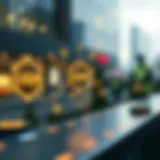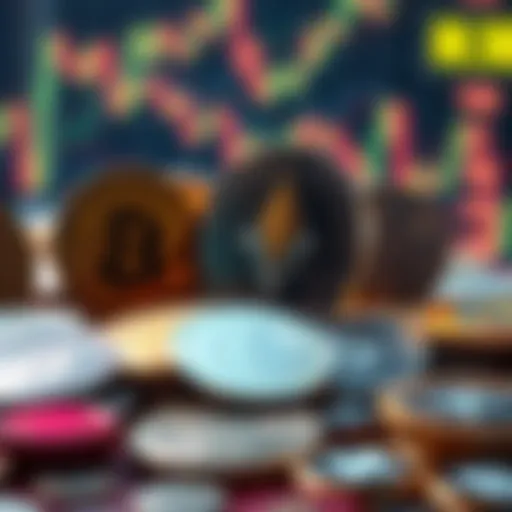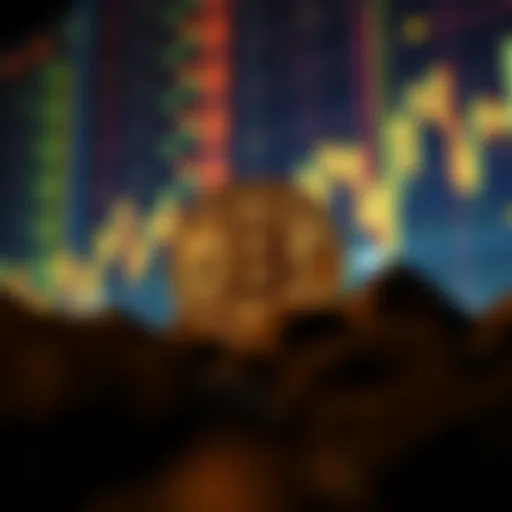Creating NFT Art: A Comprehensive Guide for Artists
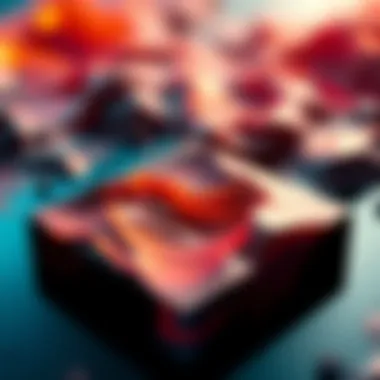
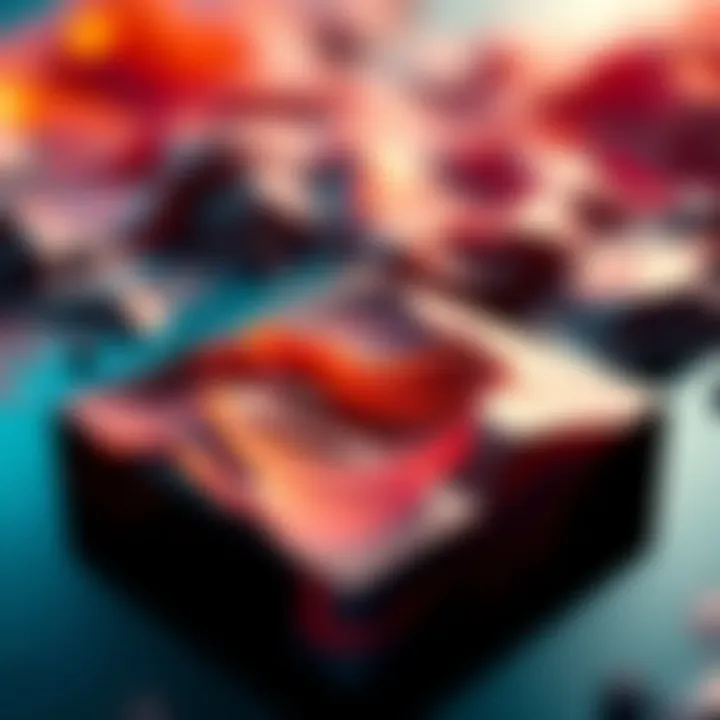
Intro
The world of digital art has shifted dramatically with the rise of non-fungible tokens (NFTs). Artists can now get their work in front of a global audience and monetize their creations in ways that were previously unimaginable. As we traverse this new terrain, it's crucial to understand not just the aesthetic aspects of creating NFT art, but also the intricate layers of market dynamics, proper tools, and the legal landscape that accompanies this burgeoning trend.
This guide aims to provide a deep dive into producing compelling NFT art, navigating through essential topics that artists and creators should be aware of. We will elucidate the tools required, the step-by-step minting process, and how to effectively market your digital masterpieces while considering the legal ramifications. By equipping yourself with this knowledge, you can turn your passion into a lucrative venture in the competitive NFT marketplace.
Market Analysis
Undoubtedly, understanding the market is foundational if you aspire to succeed as an NFT artist. Grasping the current trends and price prediction techniques can enable you to make informed decisions.
Current Trends in Cryptocurrency
In recent years, the cryptocurrency scene has been rife with volatility, yet it remains robust and dynamic. With platforms like OpenSea and Rarible gaining traction, artists are increasingly embracing the digital space.
Here are some current trends contributing to the prominence of NFT art:
- Emission of Eco-Friendly NFTs: There’s an emerging focus on environmentally friendly blockchain technologies, spurring up projects that significantly reduce carbon footprints. Artists are keen on adopting these platforms to resonate with eco-conscious audiences.
- Gamification Elements: Creators are beginning to infuse gamified elements into their art, merging aesthetics with interactive features. This invites buyers to engage and retake ownership in unique ways.
- Cross-Platform Integration: Artists can tap into multiple platforms for broader exposure and diverse income streams.
Price Prediction Techniques
Understanding price movements is crucial to make educated investments in NFT art. Here are several methods to gauge price trends that you might consider:
- Market Sentiment Analysis: Tracking social media buzz and community discussions—especially on platforms like Reddit—can uncover trends before they explode.
- Historical Data Examination: Regularly assessing how similar NFT art has performed historically gives clues to possible future valuations.
- A/B Testing: Artists can release two pieces with varying qualities and styles to see which garners more interest, thus better informing future sales strategies.
"Market behavior is as unpredictable as the weather, but informed strategies can offer some semblance of clarity."
Armed with these insights, artists and investors no longer wade in murky waters. Instead, you can get a clearer view of your surroundings, preparing you to adapt and thrive.
Investment Strategies
Navigating the world of NFT art investment requires a blend of astuteness and strategy. Whether you are dipping your toes or taking the plunge, having a solid investment strategy is imperative.
Long-Term vs Short-Term Investing
When it comes to NFTs, there are generally two schools of thought:
- Long-Term Investing: This approach focuses on acquiring pieces you believe will appreciate over time. It’s about cultivating a collection with potential cultural or market significance.
- Short-Term Flipping: On the other hand, some artists may focus on quick sales, creating artworks that tap into current trends before moving onto the next big thing.
Risk Management in Crypto Trading
In the rapidly changing landscape of NFTs, managing risk cannot be overlooked. Here are some practices worth involving yourself in:
- Diversifying Your Portfolio: Don't put all your eggs in one basket. Explore different genres, platforms, or emerging artists to spread risk.
- Setting Clear Budgets: Outline what you’re willing to spend and stick to it, avoiding impulsive purchases.
- Staying Updated: The NFT market can change overnight. Staying informed through sources like Investopedia and tracking updates on platforms like CoinDesk allows you to adjust accordingly.
With a blend of artful creativity and strategic foresight, artists can navigate the landscape of NFT art and carve their paths to success.
As we delve deeper into the subsequent sections, we will explore the tools and platforms that facilitate the creation and distribution of NFT artworks, ensuring you are well-equipped for your journey into this exciting domain.
Understanding NFTs
In today's rapidly transforming digital landscape, grasping the concept of Non-Fungible Tokens, or NFTs, is essential for anyone looking to navigate the intriguing world of digital art. As artists, investors, and tech enthusiasts dive into this arena, understanding NFTs becomes not just beneficial, but crucial. They enable ownership verification and authenticity in a space that often lacks such clarity.
What exactly are NFTs? It’s clear that NFTs represent a significant shift in how we perceive art and ownership in the digital domain. Instead of being mere copies of a piece that can be easily replicated, NFTs establish one-of-a-kind ownership rights over digital assets. This change allows for new forms of engagement between creators and consumers and opens the door for artists to profit from their work in unprecedented ways.
Definition of NFTs
Non-Fungible Tokens, or NFTs, are digital certificates of ownership that exist on a blockchain. Unlike cryptocurrencies such as Bitcoin or Ethereum, which are fungible and can be exchanged one-for-one, NFTs are unique and cannot be interchanged in this manner. Each NFT contains distinct information that makes it different from every other token, even those that depict similar assets.
In essence, consider an NFT as a digital version of a signed piece of artwork or a collectible trading card. While anyone can create and replicate digital art, the NFT acts as proof that the owner possesses an original or limited edition. This validation aspect is what drives much of the value and excitement around NFTs in the art market.
The Technology Behind NFTs
The underpinning technology for NFTs is rooted in blockchain, which provides the framework necessary for this level of uniqueness and ownership verification.
Blockchain Basics
Blockchain technology allows multiple users to securely share and store data in a decentralized manner. Each transaction or data entry is recorded in blocks and linked in chronological order, forming a chain of information that is immutable and transparent. This is essential for NFTs, as it ensures the provenance of the artwork and that its authenticity can always be traced.
A key feature of blockchain is its decentralization, which means it operates without a central authority. This aspect reduces the risk of fraud, as anyone can verify a transaction's history. Furthermore, transactions in blockchain are generally faster and cheaper than traditional methods. However, the technology does have its drawbacks, like scalability issues and high energy consumption, which have raised concerns about the environmental impact of NFTs.
Smart Contracts
Smart contracts represent self-executing contracts with the terms directly written into code. These contracts automate and enforce the execution of agreements, which is particularly beneficial in the context of NFTs. When an artist mints an NFT, they can embed specific terms within the smart contract, such as royalty percentages for future sales. This ensures that artists continue to benefit from the resale of their work, something that traditional art sales often neglect.
One of the main advantages of smart contracts is their ability to simplify transactions and reduce the need for intermediaries, providing artists greater control over their work. However, they can also be complex and may contain bugs that could be exploited, making an understanding of the intricacies important for creators.
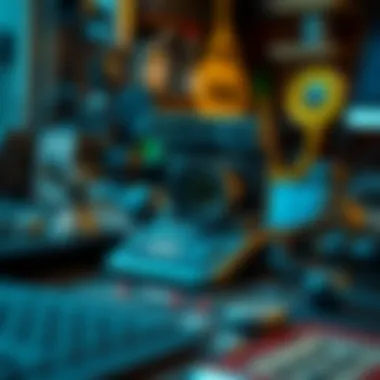

Evolution of Digital Art Ownership
The evolution of digital art ownership has shifted dramatically with the introduction of NFTs. Traditionally, digital art suffered from a lack of credibility and ownership verification. Art could easily be copied or downloaded without proper attribution or compensation for the original creator.
With NFTs, the narrative has changed. Digital art can now hold similar value to physical artwork, creating a renewed respect for the creative process. Collectors can invest in unique pieces with confidence, as ownership records are indisputable, and artists can freely engage in the marketplace, making it a win-win situation for both parties.
"NFTs are not just a tech trend; they represent a full-scale evolution of how we consider ownership in the digital age."
Understanding these foundational elements of NFTs is vital for anyone stepping into this complex yet promising world. It shines a light on the opportunities available and prepares artists and collectors to engage meaningfully in the evolving landscape of digital collectibles.
Conceptualizing Your Artwork
When embarking on the journey of creating NFT art, conceptualization is the bedrock upon which your entire artistic endeavor stands. This phase involves delving into the depths of your creativity, drawing from various influences and personal experiences to shape your unique expression. A thoughtful approach to conceptualization not only spurs creativity but also aids in crafting a compelling narrative behind your art, which is crucial in the crowded landscape of digital collectibles.
Finding Inspiration
Researching Current Trends
In the fluid world of NFT art, staying abreast of current trends matters significantly. Observing what is popular can guide your creativity and align your work with market demands. It gives you insight into what resonates with buyers right now. For example, there are trends revolving around specific themes like abstract representations or social commentary.
Engaging with platforms like reddit.com can expose you to a myriad of opinions and concepts in real-time. What’s trending isn't just about mimicking; it’s about understanding the pulse of the audience.
However, one must tread cautiously. Relying too much on trends can confine your original vision, potentially diluting the authenticity of your work. Therefore, while trends can serve as a compass, let your distinct voice chart the course.
Identifying Your Unique Style
Art is personal. Identifying your unique style is about understanding your preferences and artistic principles. It sets you apart, allowing your work to stand as a testament of who you are as an artist. By honing in on the characteristics that define your artwork, you can cultivate a recognizable signature style that speaks volumes without uttering a word.
One effective way to pinpoint this style is engaging in self-reflection and experimentation. Create various pieces, explore different techniques and themes, and take note of what excites you. The key characteristic of this process is exploration. It opens doors to unexpected directions, allowing for a natural evolution that is both personal and relatable.
A caveat to consider is that developing a unique style should not be rushed. This process takes time and requires patience and self-compassion. Embracing your artistic journey, with all its twists and turns, is fundamental to discovering what truly resonates with you.
Developing an Artistic Concept
Theme and Message
Choosing a theme for your artwork is akin to setting the stage for a performance. It provides context, offering the viewer something to grasp onto while navigating your creation. A strong theme can evoke emotion, provoke thought, or simply delight. One powerful aspect of a well-chosen theme is its capability to resonate with your audience on multiple levels.
Selecting a theme should be deliberate. Ask yourself: what message do I want to convey? Themes can span the spectrum from personal experiences to broader societal narratives. The ability to articulate this message succinctly enhances not only the visual appeal of your art but also its relatability in the NFT marketplace.
Nonetheless, balance is needed; a strong theme that overshadows the artwork may steer it into being didactic rather than engaging. Finding that equilibrium invites viewers to stroll through your artistic landscape without feeling lost.
Target Audience Consideration
Understanding your target audience is pivotal in creating successful NFT art. It shapes your choices, from content to presentation. Are you appealing to collectors interested in emerging styles, or are you targeting connoisseurs looking for critical commentary? Your audience influences not just the broader narrative, but even the finer details of your piece, such as color choices and motifs.
Analyzing community feedback on platforms like facebook.com can provide valuable insights about what resonates with potential buyers. Additionally, engaging in dialogues on forums or social media can help clarify what potential buyers prioritize when seeking new art.
On the downside, placing too much focus on audience preferences could sway you away from your true artistic inclinations. It is essential to find a balance where your passion meets your audience’s interest, establishing a connection without compromising your voice.
"Art is a lie that tells the truth." - Pablo Picasso
Reflect upon this idea as you journey through conceptualizing your artwork. Your artistic voice is unique and worth celebrating, so nurture it through understanding and exploration.
Digital Art Creation Tools
Digital art creation tools play a crucial role in the process of producing NFT art. These tools enable artists to translate their creative ideas into a digital format that can be minted as NFTs. The variety of software and hardware options available caters to different artistic styles and preferences, allowing artists to choose instruments that best enhance their work. Consequently, understanding the available digital art creation tools is imperative for artists aiming to make a mark in the NFT landscape.
Software Options for Creating Digital Art
Illustration Software
When we talk about illustration software, we're diving into tools like Adobe Illustrator and Procreate. These platforms are central for artists focusing on creating vector images and intricate designs. One standout characteristic of Adobe Illustrator is its robust vector editing capabilities. This means that artwork produced doesn't lose quality regardless of scaling, a major plus when creating NFTs that might be viewed across different platforms.
A unique feature of Procreate is its intuitive interface, making it a go-to for many digital illustrators, especially on the iPad. However, while it is renowned for its versatility, it may not be the first choice for artists who prefer working on a desktop. The choice of software ultimately impacts the quality and appeal of NFT artworks, which is why it's essential to select one that aligns with an artist's style and requirements.
Animation Tools
Animation tools, such as Adobe After Effects and Blender, enable artists to add an extra layer of creativity to their NFTs. These programs provide a means to create mesmerizing animations that can capture the attention of potential buyers. A notable characteristic of After Effects is its extensive library of effects and preset animations, which can simplify the animation process significantly. For those interested in 3D elements, Blender is a fantastic free alternative that allows for intricate modeling and animation.
However, the steeper learning curve associated with these animation tools may deter some newcomers. Still, their potential to elevate a simple piece of art into a mesmerizing visual story is worth considering for NFT creators looking to distinguish themselves.
Photo Editing Software
Photo editing software, especially tools like Adobe Photoshop and GIMP, are indispensable for refining digital artwork. These applications allow artists to enhance images, adjust colors, and manipulate photographs in ways that elevate their visual appeal. Photoshop is celebrated for its powerful editing capabilities and vast range of filters. Its layer-based approach allows for non-destructive editing, which is crucial for creating and maintaining high-quality NFT images. Uniquely, GIMP is an open-source alternative that offers many similar features without the financial burden. However, it may not be as user-friendly for beginners. Ultimately, choosing the right photo editing software can greatly enhance the quality and professionalism of the NFT art produced.
Hardware Considerations
Tablets and Styluses
Tablets and styluses have transformed the way many artists create their work. The most well-known of these tools includes the Wacom tablets and Apple Pencil. The primary advantage of using a tablet is the precision and sensitivity it offers, allowing for natural drawing experiences. For instance, the pressure sensitivity of styluses lets artists vary line thickness, a feature essential for detailed work.
One limitation some artists face is the requirement for additional software, which may not be well integrated with all hardware. Depending on the tablet's compatibility, the seamlessness of the creative process can vary significantly.
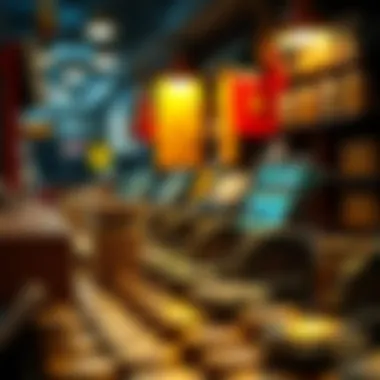

Computers and Laptops
The choice of computers and laptops is also vital in the realm of digital art creation. High-performance machines equipped with powerful graphics cards, like the MacBook Pro or custom-built gaming desktops, can handle graphic-intensive tasks without a hitch. This capability is essential for running demanding software like Adobe Suite or 3D rendering tools.
The right computer can make a substantial difference in workflow efficiency, especially for artists working with complex layers or high-resolution images. However, the price of high-end hardware can be a drawback for emerging artists.
"The investment in reliable software and hardware often pays off by enhancing creativity and efficiency, essential for succeeding in the competitive NFT market."
In summary, selecting appropriate digital art creation tools is fundamental for any artist embarking on the journey into NFTs. From software choices to hardware setups, each decision shapes the artistic process and ultimately the success of the NFT artwork. Having a solid understanding of these tools empowers artists to bring their visions to life while effectively engaging with the NFT community.
Preparing Your Artwork for NFTs
The journey of crafting NFT art doesn't end with the creative process. There’s a critical phase that artists must engage in: preparing their artwork for the NFT marketplace. This step is not just about having the perfect piece; it’s about ensuring that it is presented in a way that maximizes its potential to resonate with buyers. Factors like file formats and adding metadata play a significant role here, influencing how the art is experienced and discovered.
File Formats and Resolutions
When preparing your artwork for NFTs, understanding file formats and resolutions is paramount. Various platforms support different file types, which can affect how your art displays and interacts with viewers. Common formats include JPG, PNG, GIF, and MP4, each catering to specific needs. For instance, PNGs are great for maintaining transparency, which can be a selling point for certain styles.
Resolution is another critical factor. A higher resolution means better image quality, crucial for detailed artwork. It’s worth noting that some marketplaces might impose limits on file sizes, meaning striking a balance between resolution and compliance is important. Additionally, being wary of scaling issues will help ensure your piece looks fantastic across devices, be it a smartphone, tablet, or desktop.
Adding Metadata to Your Art
Metadata serves as the backbone of digital art's discoverability. It's not just an option; it’s a necessity, perhaps like ice cream in a summer heatwave. It provides context and helps potential buyers understand the essence of your work. In the realm of NFTs, metadata encompasses titles, descriptions, and essential tags that can guide the artwork’s visibility.
Importance of Descriptions
Descriptive text is vital for potential buyers. It’s much more than simply stating the title of your artwork. A thoughtfully crafted description can evoke emotions, detail the inspiration behind the piece, and explain the techniques used. This sort of narrative can be the difference between a passing glance and a genuine interest.
A good description not only informs but also allows the viewer to connect on a deeper emotional level with the piece.
Having a detailed description also aligns with the practice of forming strong connections with collectors. It brings your story to the forefront, making it a compelling choice for buyers who are often seeking a narrative as much as they seek aesthetic value. A well-written description can attract a wider audience by appealing to art enthusiasts, investors, and casual viewers alike, each looking for different reasons to engage with your art.
Tags and Keywords
Tags and keywords are like breadcrumbs that lead potential buyers back to your artwork. They are essential for enhancing searchability within NFT marketplaces. When you strategically choose relevant tags—think about what art lovers are typing in the search bar—you increase the chance of your piece popping up during their exploration.
The careful selection of keywords not only boosts visibility but also effectively categorizes your work. This can ease the discovery process for less tech-savvy buyers or art patrons checking out new additions. However, overstuffing your artwork with tags can lead to an adverse effect. Quality over quantity should be the mantra here, ensuring that each tag truly resonates with your work and aligns with the narratives behind it.
In the ever-competitive realm of NFTs, taking the time to prepare your artwork meticulously can yield significant benefits. By understanding file formats, utilizing high-quality resolutions, crafting meaningful descriptions, and strategically using tags and keywords, artists can significantly enhance their chances of not only selling their work but also of gaining a loyal following among enthusiastic collectors.
Minting Your NFT
Minting is a crucial step in the world of NFTs, where individuals transform their digital artwork into unique, ownable tokens on the blockchain. The importance of this process cannot be overstated, as it marks the moment where creativity meets technology. By minting your NFT, you create a one-of-a-kind digital asset that can be bought, sold, or traded like a physical piece of art. This not only provides a means for artists to monetize their works but also establishes proof of ownership and authenticity. Failure to understand the minting process can leave artists vulnerable to piracy and resale issues, hence it’s vital for one to grasp its nuances thoroughly.
Choosing the Right Marketplace
Choosing the right marketplace is like picking the perfect stage for a performance—it can make all the difference in the visibility and saleability of your artwork. Not all marketplaces are created equal, and selecting one tailored to your individual needs can enhance your chances of success. Depending on your target audience and the type of art you create, your options might vary widely.
Evaluating Popular Platforms
When it comes to evaluating popular platforms, you’re basically looking at the arena where your art will compete. Each platform has its unique user base and operational style. For instance, OpenSea is known for its broad reach, allowing artists to sell a wide variety of digital assets. Meanwhile, Rarible offers community governance, encouraging engagement from users.
- Key Feature: OpenSea’s user-friendly interface makes it accessible for newcomers, while Rarible’s reward system can attract those looking to engage more deeply with their audience.
- Advantages: Popular platforms often provide increased exposure, community engagement tools, and robust support resources.
- Disadvantages: The trade-off includes higher competition and possibly crowded marketplaces, which might make standing out quite challenging.
Understanding Fees and Structures
Understanding fees and structures in the NFT world is like reading the fine print of a contract; it can save you from unwelcome surprises. Different marketplaces have varying fee structures, often charging a percentage of each sale or setting fixed fees for listing your art.
- Key Characteristic: Some platforms, like Foundation, work on an invite-only basis, which might mitigate competition but also restrict access.
- Unique Feature: Gas fees, which are the costs associated with processing transactions on the blockchain, can fluctuate dramatically depending on network congestion. This can impact the total cost of minting and selling your NFT.
- Advantages/Disadvantages: While platforms can offer lower fees or niche audiences, those low fees can sometimes be offset by additional hidden costs or fewer buyers willing to spend.
The Minting Process Explained
The minting process itself may seem intimidating at first glance, but breaking it into manageable steps can simplify the endeavor significantly. Understanding each phase can empower you to create and sell NFTs effectively.
Step-by-Step Guide
A step-by-step guide demystifies the minting process and helps you navigate the labyrinth of options available. Typically, the steps include:
- Choose a Marketplace: Decide where you want to mint and sell your NFT. This greatly influences your audience.
- Create a Wallet: Set up a digital wallet to store your NFTs and any cryptocurrency earnings.
- Upload Art: Submit your digital art file, paying close attention to required formats and sizes.
- Fill in Details: Add titles, descriptions, and tags to ensure potential buyers can find your artwork.
- Mint Your NFT: Follow the platform's instructions to finalize the minting process.
- Key Characteristic: Each step is like a piece of a puzzle, fitting together to create a complete picture of your digital art’s journey.
- Advantages/Disadvantages: While some steps may seem straightforward, artists can run into hurdles if they overlook platform specifications or misunderstand gas fees.
Common Challenges and Solutions
Every artist faces hurdles during the minting process. Recognizing these challenges early can save time and frustration.

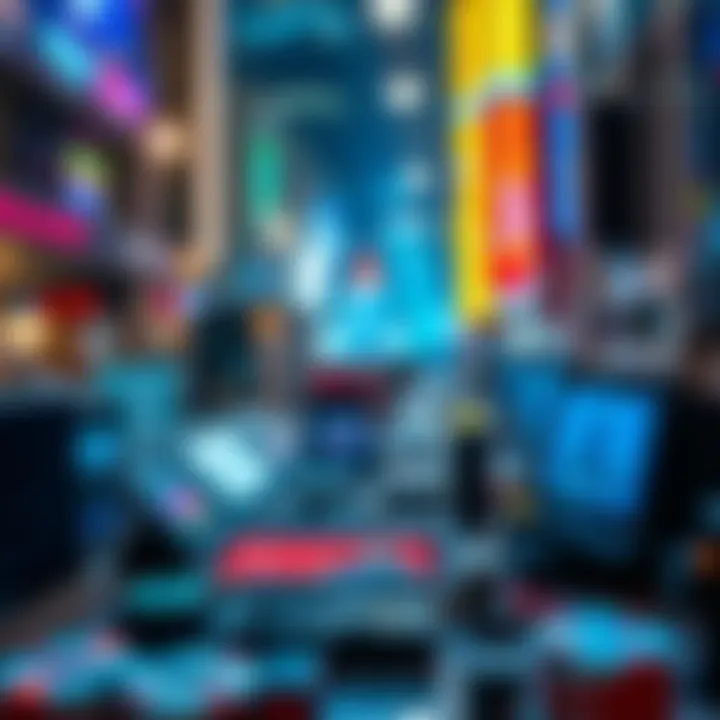
- Key Challenge: One common challenge is grappling with fluctuating gas fees, which can impact when an artist chooses to mint.
- Solution Options: Monitoring network activity and choosing times of lower congestion can minimize costs.
- Key Challenge: Another issue is creating art that resonates in a crowded marketplace, where saturation might drown out newcomers.
- Solution Options: Engaging with potential buyers and marketing your work can foster a community that supports your unique vision.
Understanding the minting process, its associated costs, and how to navigate the obstacles that may arise will place you in a stronger position in the growing NFT landscape.
Marketing Your NFT Art
In the bustling world of NFTs, marketing is crucial. Just having a great piece of art isn't enough; it needs to be seen by the right people. Marketing your NFT art not only promotes your work but also builds a brand identity around you as an artist. This helps to create ongoing interest and establishes a loyal following, which can lead to more sales and opportunities in the long run.
Building a Community
Social Media Strategies
When it comes to marketing NFT art, social media is the bedrock. Platforms like Twitter, Instagram, or TikTok foster connections that can uplift your visibility. The beauty of social media lies in its ability to reach a vast audience quickly, making it a prominent choice for artists. You can share your creative process, engage your audience with behind-the-scenes glimpses, and participate in discussions about your art.
Social media engagements can build a loyal community. Artists have success sharing snippets of their work or posting progress updates, which helps in creating anticipation. Yet, one tends to juggle the balance between promotion and authenticity; too much selling can wash over genuine connections with followers. It’s about creating a presence, not just a product.
Some useful strategies include:
- Posting consistently with engaging content
- Collaborating with fellow creators to expand audience reach
- Hosting Q&A sessions to allow your audience to know you better
Engaging with Potential Buyers
Creating a dialog with potential buyers is another piece of the marketing puzzle. It’s not just about displaying art; it’s about understanding who your audience is and what they value. Engaging with potential buyers helps in building trust. People are more prone to buy from someone they feel connected to. This could mean responding to comments on your posts, participating in forums, or inviting collectors to give feedback on your works.
The key characteristic of this engagement is approachability. Invite discussions about your art, ask questions, and encourage feedback. This creates a personal touch that can resonate with buyers. It can also lead to valuable insights that inform your future projects. However, be cautious; oversharing can backfire and lead to losing that professional boundary.
"Engagement is not just a tactic; it is about forming a community where buyers and creators thrive together."
Promoting Your Work
Collaborations
Collaborations can serve as a springboard for marketing NFT art. Partnering with other artists or brands can draw in new demographics. When you collaborate, you not only expand your audience but also share creative ideas that enhance your work.
A fundamental aspect of collaboration is synergy; when artists combine their styles, it can lead to unique formats that intrigue buyers. However, choosing the right partner is crucial; the collaboration must mesh with your artistic vision and audience expectations.
Benefits of collaborations include:
- Increased exposure across varied art communities
- Leveraged strengths of each artist involved
- Fresh perspectives that inspire innovation
Art Shows and Exhibitions
Art shows and exhibitions present a direct way to showcase your NFT art physically while still tethering it to the digital world. These events allow for personal interaction, which can strengthen relationships with collectors and art enthusiasts. People are inherently drawn to physical spaces to experience art. In a world grappling with digital saturation, offering this tactile experience can be a powerful marketing tool.
The primary characteristic of art shows is their ability to immerse viewers in your work. They lend emotional depth that digital platforms sometimes lack. This type of promotion is advantageous, yet it requires careful planning and investment. Notably, costs can mount up for booth space, travel, and promotional materials, making budgeting essential for any artist considering this route.
Connecting with local galleries or participating in virtual exhibitions can serve as alternatives. Here, you can effectively engage potential buyers and showcase your art in a community setting.
In summary, effectively marketing your NFT art does not hinge solely on the visibility of your work but rather on fostering connections, nurturing relationships, and understanding the dynamics of the art world. By building a community through social media, engaging with potential buyers, exploring collaborations, and participating in art shows, you create a dynamic environment that enhances your overall success in this competitive market.
Navigating Legal and Ethical Considerations
Understanding the landscape of NFTs requires careful thought about legalities and ethical responsibilities. For artists venturing into the world of digital collectibles, it's essential to grasp these nuances. They not only safeguard one's work but also pave the way for responsible participation in this burgeoning market. As creators, awareness of copyright and environmental implications can make a significant difference in both the reputation and success of the art created.
Copyright and Ownership Issues
When diving into the sphere of NFTs, copyright is a pressing concern that cannot be overlooked. Traditionally, artists retain the rights to their work unless they explicitly transfer these rights to someone else, often through a licensing agreement. However, the digital nature of NFTs adds layers of complexity.
When someone buys an NFT, they acquire a token that proves ownership of a specific digital item, but not necessarily the ownership rights of the underlying artwork. This can lead to confusion. For example, if a digital art piece is sold as an NFT, the rights to print or reproduce that artwork may still belong to the creator. Artists must clearly define what rights are transferred along with the sale of an NFT to avoid misunderstandings.
Maintaining an open dialogue about ownership rights is crucial and can prevent potential legal disputes. It’s wise to include clear terms in the description of the NFT regarding what the buyer can or cannot do with the artwork. This transparency can foster trust and uphold the integrity of the art market.
Environmental Considerations in NFT Creation
Environmental awareness is becoming increasingly relevant in discussions surrounding NFTs, particularly in regards to their carbon footprint. The process of minting NFTs largely relies on blockchain technology, which can be quite resource-intensive. The high energy consumption associated with some blockchains, especially those utilizing proof-of-work systems, raises valid concerns about the impact on the environment.
Understanding Blockchain Carbon Footprint
The carbon footprint of blockchain technology stems primarily from the energy-consuming processes involved in validating transactions. This carbon impact is often highlighted as a major drawback for platforms like Ethereum, which is frequently used for NFT transactions. Even if these platforms are working on improvements, such as transitioning to proof-of-stake models, the urgency remains for artists to be conscious of the environmental implications of their work.
Acknowledging this challenge can shape an artist's approach to minting NFTs, often leading them to consider eco-friendlier platforms or methodologies. By making informed decisions, artists can reduce their environmental impact while still engaging with this new medium. * Sustainability is not just a trend; it’s becoming a necessity in the artistic landscape.
Sustainable Practices
In light of the environmental impact associated with NFT creation, artists can adopt sustainable practices to mitigate their carbon footprint. This involves choosing energy-efficient platforms that prioritize environmentally friendly technologies and practices. Such platforms might utilize renewable energy or more efficient consensus mechanisms, significantly lessening their impact on the planet.
Artists could also look into carbon offsetting initiatives, which involve investing in projects aimed at reducing emissions elsewhere—like reforestation or renewable energy projects. While these measures may not completely eliminate the environmental effects of NFTs, they represent a step in the right direction.
In addition, sharing insights about how they are mitigating their carbon impacts can enhance an artist’s brand, appealing to an audience that increasingly values sustainability. The art world is changing, and artists who stay ahead of these trends by incorporating sustainable practices can differentiate themselves in a competitive market.
Advancing both art and environmental consciousness may initially seem daunting, but the benefits of understanding these legal and ethical nuances are worth the effort. By grasping concerns around copyright and environmental responsibilities, artists not only parallel their art with the ongoing transformations within the digital realm but also contribute positively to the broader discourse surrounding NFTs.
